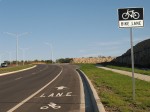Bicycling in Rural Communities
 Many larger communities are seeing the benefits that bicycling can have on health and well-being, their economy, and their image. Some are beginning to incorporate this activity as a mission objective in their comprehensive plans, while others are moving forward actively with bicycle-specific master plans. These plans call for improved infrastructure, ordinances, education, and advocacy. Some invent the process on their own and some use guidance from the League of American Bicyclists. Whatever process they choose, it has to be right for their own community because not all communities are the same.
Many larger communities are seeing the benefits that bicycling can have on health and well-being, their economy, and their image. Some are beginning to incorporate this activity as a mission objective in their comprehensive plans, while others are moving forward actively with bicycle-specific master plans. These plans call for improved infrastructure, ordinances, education, and advocacy. Some invent the process on their own and some use guidance from the League of American Bicyclists. Whatever process they choose, it has to be right for their own community because not all communities are the same.
How should smaller, rural communities approach bicycling and planning? Some recognize bicycles as traffic and some create specific infrastructure to support the activity. Whether for recreation, commuting or sports, bicycling should be available for all ages and ability levels. I believe that increased ridership should be the overall goal and with increased ridership comes increased responsibility for all users of public ways.
Most rural communities have neither the budgets nor the expertise to install bicycle specific infrastructure, but there are ways every community can plan to make bicycling a safe, enjoyable experience for their citizens. Designating safe routes to schools, for example, is a great way to provide safe bicycle routes for our younger members to use on a daily basis. Providing racks and areas for bicycle parking in retail and governmental areas to promote the idea of bicycling as a form of transportation. Encouraging local business and industry to make accommodations for bicycling employees through the installation of lockers, changing rooms, secure bicycle storage and shower facilities is a great way to increase ridership. But mostly, increasing the awareness and education of safety among all road users is paramount to preserving the small-town safe activity of bicycling!
To find out more about how to promote bicycling in your hometown, visit the League of American Bicyclists for ideas, and considering joining the other 1,000,000 people who support bicycling advocacy at People for Bikes.
Photo credit: MoBikeFed (The Missouri Bicycle and Pedestrian Federation), from the Flickr Creative Commons, Attribution 2.0 Generic. No alterations to the original photograph.
Built Capital Cultural Capital Human Capital Social Capital
